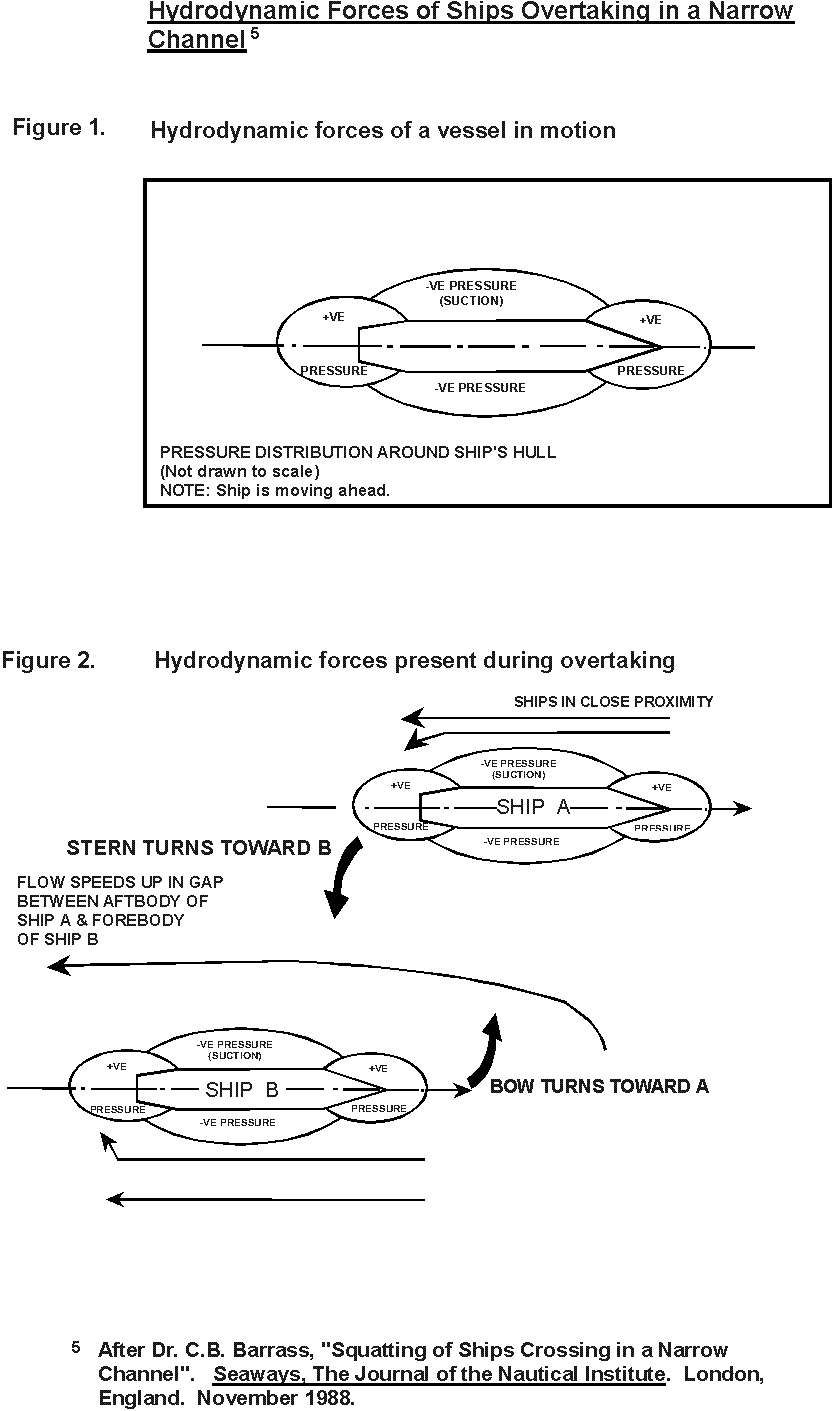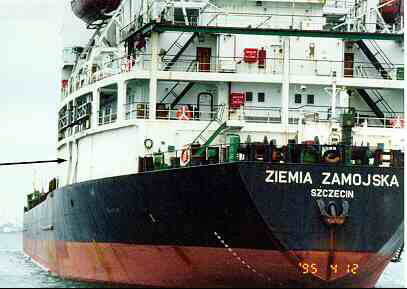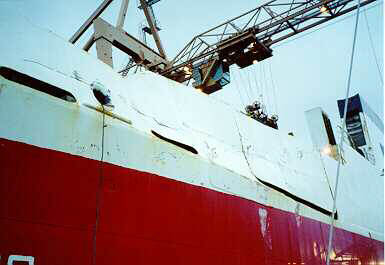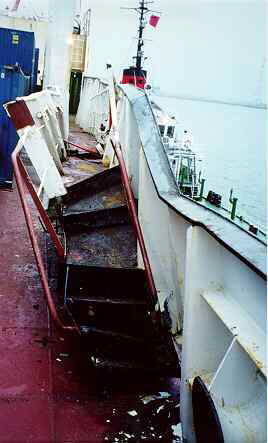Collision - Between the Bulk Carrier "ZIEMIA ZAMOJSKA"
and the Ro-ro Cargo Ship "CICÉRO"
in the Vicinity of Pointe du Lac
Lac St. Pierre
St. Lawrence River, Quebec
The Transportation Safety Board of Canada (TSB) investigated this occurrence for the purpose of advancing transportation safety. It is not the function of the Board to assign fault or determine civil or criminal liability. This report is not created for use in the context of legal, disciplinary or other proceedings. See Ownership and use of content. Masculine pronouns and position titles may be used to signify all genders to comply with the Canadian Transportation Accident Investigation and Safety Board Act (S.C. 1989, c. 3).
Summary
On 12 April 1995, a collision took place between the Polish bulk carrier "ZIEMIA ZAMOJSKA" and the Canadian ro-ro cargo ship "CICÉRO". Both vessels were proceeding westward, and they collided while the "CICÉRO" was overtaking the "ZIEMIA ZAMOJSKA" in the vicinity of buoy S27 in Lac St. Pierre. Both vessels sustained damage, but no one was injured and no pollution was reported as a result of this occurrence.
The Board determined that the "CICÉRO" and the "ZIEMIA ZAMOJSKA" collided when the ship being overtaken, the "ZIEMIA ZAMOJSKA", strayed beyond the heading ordered by the pilot. The helmsman's error of inattention was not detected in time because the full attention of the bridge watch was focused on the overtaking vessel.
1.0 Factual Information
1.1 Particulars of the Vessels
| Name | "ZIEMIA ZAMOJSKA" | "CICÉRO" |
|---|---|---|
| Official number | ROS1616 | 376894 |
| Port of registry | Szczecin, Poland | St. John's, Newfoundland |
| Flag | Polish | Canadian |
| Type | Bulk carrier | Ro-ro cargo ship |
| Gross Tons<1> | 16,694Footnote 1 | 11,819 |
| Length | 180.31 m | 147.17 m |
| Breadth | 23.10 m | 22.53 m |
| Draught | F<2>Footnote 2: 7.75 m A: 7.85 m |
F: 4.91 m A: 6.42 m |
| Built | 1983, Brazil | 1978, Great Britain |
| Propulsion | Diesel engine of 7,840 kW, driving a fixed-pitch propeller | Two Diesel engines, 10,740 kW, driving two controllable-pitch propellers |
| Owners | Polish Steamship Co., Szczecin, Poland | Oceanex Ltd., Montreal, Quebec |
1.2 History of the Voyages
On the morning of 12 April 1995, two vessels were proceeding westward within the boundaries of the harbour in Trois-Rivières, Quebec. The first, the "ZIEMIA ZAMOJSKA", bound for the Great Lakes, was travelling at an average speed of about 11 knots. The second vessel, the "CICÉRO", was travelling at an average speed of 14 knots, bound for Montreal, Quebec. At about 0635Footnote 3, the "ZIEMIA ZAMOJSKA" changed pilots at the Pointe-des-Ormes pilot station and then, at 0645, the "CICÉRO" also changed pilots. The "CICÉRO" was some 1.5 nautical miles astern of the Polish bulk carrier.
At about 0700, the "CICÉRO" was at the mouth of the Nicolet River, half a mile astern of the "ZIEMIA ZAMOJSKA" and preparing to overtake her. The pilot of the "CICÉRO" contacted the pilot of the "ZIEMIA ZAMOJSKA" on channel 13 of the very high frequency (VHF) radiotelephone, and an overtaking agreement was reached between the two pilots whereby the "ZIEMIA ZAMOJSKA" would keep to the north side of the channel, and the "CICÉRO" to the south side.
After this agreement had been reached with the "CICÉRO", the "ZIEMIA ZAMOJSKA" came to the curve at the intersection of the Nicolet Traverse and the Pointe-du-Lac Course and steered on a heading of 270· true (T). Shortly thereafter, the vessel began to turn gradually to port. The course was altered in stages to 265· and then 260·(T), and, abreast of buoy S22, the pilot of the "ZIEMIA ZAMOJSKA" ordered 255· and 250·(T) while the bow of the "CICÉRO" was observed on the port beam of the "ZIEMIA ZAMOJSKA". Some 300 m (1,000 feet) from buoy S26, the pilot of the "ZIEMIA ZAMOJSKA" ordered the helmsman to steer 240·(T) to make for the Pointe-du-Lac Course. On the "ZIEMIA ZAMOJSKA", the full attention of the bridge watch and the helmsman was focused on the "CICÉRO" which was on the port beam of their vessel.
Suddenly, the pilot of the "ZIEMIA ZAMOJSKA" observed buoy S27 coming up fast ahead of the vessel and, at the same time, noticed that the rudder angle indicator showed hard-a-port. The pilot shouted to the helmsman to bring the helm midships and hard-a-starboard, and then he radioed the pilot of the "CICÉRO" to warn him to watch out because there had been an error on board.
The bridge watch on the "CICÉRO" observed the "ZIEMIA ZAMOJSKA" turning to port to steer on the Pointe-du-Lac Course. They noted that the vessel was turning fast, and then, following the warning of the pilot of the "ZIEMIA ZAMOJSKA", they understood that the vessel was in difficulty. The course of 240·(T) was immediately altered to 230· and 220·(T) in an effort to keep the "CICÉRO" parallel to the "ZIEMIA ZAMOJSKA". As the latter began to straighten out by turning to starboard, the "CICÉRO" did likewise in an effort to remain parallel to the "ZIEMIA ZAMOJSKA". The two vessels were side by side, with the bows at an angle of about 30 °. The sterns were close to each other, and were affected and drawn together by hydrodynamic forces generated between the two vessels, and the vessels collided at about 0712 on 12 April 1995 near buoy S27 in Lac St. Pierre.
1.3 Injuries to Persons
There were no casualties as a result of this occurrence.
1.4 Damage
The "ZIEMIA ZAMOJSKA" suffered limited damage under the accommodation ladder at the stern on the port side and above the main deck. The upper deck was set up over approximately 2 m. Two T-bars used for launching the lifeboat between the upper deck and the main deck were staved in and bent out of shape. The damage where the hull was staved in covered an area about 9 m long by 3.5 m wide.
The "CICÉRO" suffered limited damage to the starboard quarter beginning 6.7 m aft of the smokestack over about 13.5 m toward the stern. The damaged portion included a ventilation trunk, the walkway and a bulwark, which were staved in, and some bent frames.
1.5 Certification
1.5.1 Vessels
Both vessels met the manning, certification and equipment requirements in accordance with existing regulations.
1.5.2 Personnel
The crew members on both vessels who were directly involved in the collision held the appropriate certificates for their positions and for the service in which their vessel was employed. The pilots on board the "ZIEMIA ZAMOJSKA" and the "CICÉRO" both held the appropriate qualifications.
1.6 Personnel History
1.6.1 Masters
The master of the "ZIEMIA ZAMOJSKA" has been sailing as a master since 1986; prior to that, he served as chief officer on a training vessel. He has been in command of the "ZIEMIA ZAMOJSKA" since 1994, and he made his first voyage on the St. Lawrence River and the Great Lakes aboard that vessel.
The master of the "CICÉRO" has been sailing as a master since 1989, and has served on the "CICÉRO" for the past four years.
1.6.2 Officers
The first mate on duty on the "ZIEMIA ZAMOJSKA" has been sailing since 1980, and has been a first mate since 1990.
The first mate on duty on the "CICÉRO" graduated from the Institut maritime du Québec in 1988. He has worked for the same company for six years, the last three as a first mate.
1.6.3 Pilots
The pilot on duty on the "ZIEMIA ZAMOJSKA" began as an apprentice pilot in 1967, and has been a Class A pilot between Trois-Rivières and Montreal since 1977.
The pilot on duty on the "CICÉRO" began as a pilot in 1968, and has been a Class A pilot between Trois-Rivières and Montreal since 1973.
1.7 Weather and Current Information
According to the evidence from the bridge watch on both vessels, the weather was clear with good visibility. The wind was from the south-east at 10 knots, and the sea was calm. The direction of the current in the area of the collision was 040·, and its speed was calculated at 1.5 knots.
1.8 Navigation Equipment
Both vessels were equipped with modern navigational aids in good working order at the time of the occurrence. The course recorder on the "ZIEMIA ZAMOJSKA" was operating and recorded the course and the rudder angle, but the time had not been adjusted.
The "CICÉRO" is equipped with an Electronic Chart Precision Integrated Navigation System (ECPINS) unit which had been placed on board for evaluation prior to any permanent installation. It is a stand-alone unit and only receives gyro heading and Differential Global Positioning Signals (DGPS) information. This unit does not show any radar targets and serves only as a navigation aid. Additionally, the bridge has two Racal Decca BridgeMaster radars for navigation and anti-collision purposes. The Racal Decca radar closest to the ECPINS is fitted with "Autotrack" and "Geographic" packages. The "Autotrack" function is similar to an Automatic Radar Plotting Aid (ARPA), but without the trial manoeuvre feature. The "Geographic" package, among other things, allows the construction, display and maintenance of charts. It can also record and display history tracks. The navigation data stored on a memory disk can be amended and updated to take account of notices to mariners; however, the vessel track information as recorded cannot be altered.
At the time of the occurrence, the Differential Global Positioning System (DGPS) on the "CICÉRO" was in operation and was recording the position of the "CICÉRO" every three minutes, but the radar echo of the "ZIEMIA ZAMOJSKA" was not tracked and recorded during the overtaking operation.
1.9 Communications Between the Vessels and the Montreal Vessel Traffic Centre (VTC)
In sector No. 4 of the Montreal VTC where the collision occurred, the communication channel between ships and the VTC is frequency 156.65, VHF channel 13.Footnote 4
The VHF radiotelephones were working normally on both vessels.
At 0634, the "ZIEMIA ZAMOJSKA" reported passing Pointe des Ormes to the VTC and gave an estimated time of passing Yamachiche, Quebec, of 0735. The following vessel, the "CICÉRO", reported passing Pointe des Ormes at 0645 and gave an estimated time of passing Yamachiche of 0725. These communications proceeded normally. At 0713, the pilot of the "ZIEMIA ZAMOJSKA" reported to the VTC that a collision had occurred with the "CICÉRO" at about 0710.
The recordings of the radio conversations preceding the collision show that the "CICÉRO" and the "ZIEMIA ZAMOJSKA" were in direct radio contact before, during and after the collision. The first contact was at 0659 concerning an overtaking agreement between the two vessels. The second contact was at 0710 when the pilot of the "ZIEMIA ZAMOJSKA" called the pilot of the "CICÉRO" to warn him to watch out. During the last conversation, at 0714, the "CICÉRO" asked the "ZIEMIA ZAMOJSKA" to reduce speed.
1.10 Bridge Watch
"ZIEMIA ZAMOJSKA"
The first mate, who was the officer of the watch (OOW), was in the wheel-house with the pilot, an apprentice and a helmsman. The master had left the bridge a few minutes before the collision.
"CICÉRO"
The master, the first mate, who was the OOW, the pilot and a helmsman were in the wheel-house.
1.11 Helmsman
1.11.1 Experience
The helmsman of the "ZIEMIA ZAMOJSKA" had been sailing for 14 years, the past 3 on board merchant vessels. Prior to that, he worked on deep-sea fishing vessels. He was certificated as a helmsman for merchant ships in 1991. His previous experience as a helmsman consisted of serving as helmsman on one voyage on the Mississippi River. The occurrence voyage was his first as helmsman on the St. Lawrence River. Since the vessel entered Canadian waters, he had served as helmsman for approximately 15 minutes to replace the apprentice during his meal break.
1.11.2 Duties
The duties of the helmsman of the watch at the time of the collision can be summarized as follows: normally, at sea, he would work on deck eight hours a day and very occasionally as helmsman. He had been assigned to the 4-to-8 watch, during which time he shared the duty as helmsman with an apprentice. During the 4-to-8 watch on 12 April 1995, the apprentice had the helm from 0400 to 0600 and, at the time of the collision, the helmsman had been at the helm since 0600.
1.11.3 Incident
East of the Pointe-des-Ormes pilot station, while the helmsman of the watch was at the helm, the pilot had to intervene to correct a course that he had ordered and the helmsman had misinterpreted. This incident was not reported to the relief pilot when he boarded the vessel at the Pointe-des-Ormes pilot station.
1.12 Language of Communication
All radio communications between the "ZIEMIA ZAMOJSKA", the "CICÉRO" and the VTC were in French. The wheel orders were given to the helmsman in English, and the helmsman would repeat the heading and carry out the course alteration.
1.13 Navigation in the Area of the Collision
The collision occurred in the vicinity of the curve at the intersection of the Nicolet Traverse and the Pointe-du-Lac Course. In this area, ships have to make course alterations totalling 40 ° over a distance of 1.2 nautical miles, and the width of the curve is approximately 400 m.
1.14 Observations of the Bridge Watch
The bridge watch on the "ZIEMIA ZAMOJSKA" were all agreed that the last course ordered by the pilot was 240·, except for the helmsman who stated that the last course ordered by the pilot was 230·.
The bridge watch did not notice the vessel straying beyond the ordered heading of 240·. The full attention of the watch, including the helmsman, was focused on the "CICÉRO". The pilot, for his part, realized that something was wrong when he noticed green buoy S27 coming up fast ahead of the "ZIEMIA ZAMOJSKA". He noticed, at the same time, that the rudder angle indicator showed that the rudder was hard-a-port. He reacted by shouting "hard-a-starboard" to the helmsman.
1.15 On-board Recordings
The data from the course recorder on the "ZIEMIA ZAMOJSKA" show that the bulk carrier began to turn to port to steer on the Pointe-du-Lac Course at about 0702, and that the course was altered to port in stages from a heading of 270· until the last heading of 240· ordered by the pilot. The printout also shows that the vessel strayed beyond the ordered heading of 240·, with the helm hard-a-port, to a heading of 210· before returning to starboard with the helm hard-a-starboard.
Meanwhile, the printout of the data recorded by the DGPS on the "CICÉRO" confirms that the vessel was proceeding along the south side of the channel, as agreed, to overtake and pass the "ZIEMIA ZAMOJSKA", but an unexpected swerve to port by the vessel being overtaken brought the two vessels into a close-quarters situation followed by impact.
1.16 Bridge Radar Capabilities
The Racal Decca BridgeMaster unit alongside the ECPINS on the "CICÉRO" can store ownship track as well as target track history. This data can be stored either internally or on one of two specially designed 64K removable memory cards on the front panel of the unit. Given the limited memory of the disk, it is the practice on this vessel to only store ownship track data on the disk unless an evolving situation warrants otherwise. After an uneventful voyage, the memory card is used again. In this case, the card was saved and it provided evidence as to the track of the "CICÉRO".
1.17 Mechanical and Electrical Systems
On both vessels, the propulsion plant, steering gear and all other machinery were in good working order and did not contribute to the collision.
1.18 Steering Gear
The steering gear on the "ZIEMIA ZAMOJSKA" is actuated by two power units, but only one of the power units was in use at the time of the occurrence. This runs counter to the usual practice of having both power units in operation in confined waters.
1.19 Hydrodynamic Effects and Interaction Between Ships
Vessels moving in close proximity to other vessels, particularly in shallow channels or close to banks, are subject to a phenomenon known as hydrodynamic interaction<4>. A vessel afloat, at rest, has forces acting on the hull which are hydrostatic in nature whereas a vessel in motion creates a pressure field about her (see Appendix A, Figure 1) which is accompanied by characteristic wave patterns.
When two vessels are under way on parallel or nearly parallel headings in close proximity to each other (see Appendix A, Figure 2), the above paper states, "any change in the delicate balance of pressure forces acting on the hull will cause ... large longitudinal and lateral forces coupled with powerful turning moments ... applied to the ship. These could give rise to problems in ship handling."
In some cases, the forces induced by the interaction may be greater than the ability of the vessel's rudder to compensate for such forces and lead to a loss of directional stability. In shallow water, where water flow over the hull is two-dimensional, the interaction is even more critical.
2.0 Analysis
2.1 Course Alteration
In the area where the collision occurred, ships have to make course alterations totalling 40 °. In this case, the helmsman's job was to steer by the compass and carry out the course alterations ordered by the pilot and monitored by the apprentice, who was near the helmsman. The course was altered in stages from 270· to 250·(T), and the operation was carried out by the helmsman without any difficulty. When the pilot ordered a course alteration from 250· to 240·(T), the "CICÉRO" was on the port beam of the bulk carrier. At that time, the full attention of the bridge watch, including the helmsman, was focused on the "CICÉRO". As a result, the "ZIEMIA ZAMOJSKA" strayed beyond the heading ordered by the pilot.
2.2 Inattention of the Bridge Watch on the "ZIEMIA ZAMOJSKA"
The role of the OOW in the master's absence is to see to the safety of the vessel, monitor the pilot's actions and ensure that the helmsman carries out the wheel orders and steers the course ordered by the pilot. It appears that because the "CICÉRO" was close on the port beam of their vessel, the full attention of the bridge watch on the "ZIEMIA ZAMOJSKA" was focused on that vessel.
2.3 Effort of Concentration
Some effort of concentration is required for a helmsman to maintain a desired course, particularly in a narrow channel, and especially on a curve with another vessel in an overtaking situation. Further, a less experienced helmsman has to make a greater effort of concentration to stay on course.
2.4 Hydrodynamic Effects
Notwithstanding the magnitude of the forces induced by the hydrodynamic effect between the two vessels as the "CICÉRO" was overtaking the "ZIEMIA ZAMOJSKA", the main reason for the bulk carrier straying off course was the lack of attention on the part of the helmsman and the bridge officers. The data from the course recorder show that the "ZIEMIA ZAMOJSKA" responded quickly to the helm once corrective action was taken.
3.0 Findings
- Because the "CICÉRO" was close on the port beam of their vessel, the full attention of the bridge watch on the "ZIEMIA ZAMOJSKA" was focused on that vessel.
- The pilot of the "ZIEMIA ZAMOJSKA" realized that the vessel was straying beyond the ordered heading when he noticed green buoy S27 coming up fast ahead of the vessel.
- The officer of the watch (OOW) on the "ZIEMIA ZAMOJSKA" was not monitoring the helmsman's actions and did not realize that the vessel had strayed beyond the heading ordered by the pilot.
- The data from the course recorder on the "ZIEMIA ZAMOJSKA" show that the vessel's heading went as far as 210· while the channel is oriented at 236·.
- Because of the course recorder on the "ZIEMIA ZAMOJSKA", it was possible during this investigation to determine the reason for that vessel's fast turn to port when the "CICÉRO" was passing her.
- The data recorded by the Racal Decca BridgeMaster unit on the "CICÉRO" were also useful to this investigation for establishing with certainty that the ro-ro cargo ship was on the south side of the channel as agreed.
- The last-minute collision avoidance action taken by the two vessels limited the damage.
3.1 Causes
The "CICÉRO" and the "ZIEMIA ZAMOJSKA" collided when the ship being overtaken, the "ZIEMIA ZAMOJSKA", strayed beyond the heading ordered by the pilot. The helmsman's error of inattention was not detected in time because the full attention of the bridge watch was focused on the overtaking vessel.
4.0 Safety Action
The Board has no marine safety recommendations to issue at this time.
This report concludes the Transportation Safety Board's investigation into this occurrence. Consequently, the Board, consisting of Chairperson, John W. Stants, and members Zita Brunet and Maurice Harquail, authorized the release of this report on .
Appendices
Appendix A - Sketches - Hydrodynamic Forces Between Ships
Appendix B - Sketch of the Area of the Collision
Appendix C - Photographs
Appendix D - Glossary
- A
- aft
- ARPA
- Automatic Radar Plotting Aid
- DGPS
- Differential Global Positioning System
- ECPINS
- Electronic Chart Precision Integrated Navigation System
- EDT
- Eastern daylight time
- F
- forward
- IMO
- International Maritime Organization
- K
- kilobyte(s)
- kW
- kilowatt(s)
- m
- metre(s)
- OOW
- officer of the watch
- SI
- International System (of units)
- T
- true (°)
- TSB
- Transportation Safety Board of Canada
- UTC
- Coordinated Universal Time
- VHF
- very high frequency
- VTC
- Vessel Traffic Centre
- °
- degree(s)




